25 Best Hedge Plants That Are Also Evergreen
These are the best evergreen hedge plants you can plant, whether it’s to add privacy, to create a tidy border or add height to your landscaping, these hedges may be just what you’re looking for!
Hedge plants that are evergreen have an added benefit, unlike a deciduous shrub, an evergreen one keeps its greenery all year. So you can have privacy in the winter too.
hedge plants will also help cut down on wind and sound, as well as provide a barrier and shelter for some wildlife.
I tend to decide to write articles based on when I’m faced with needing solutions of my own. That’s what helps motivate me to do dig in deep with the research.
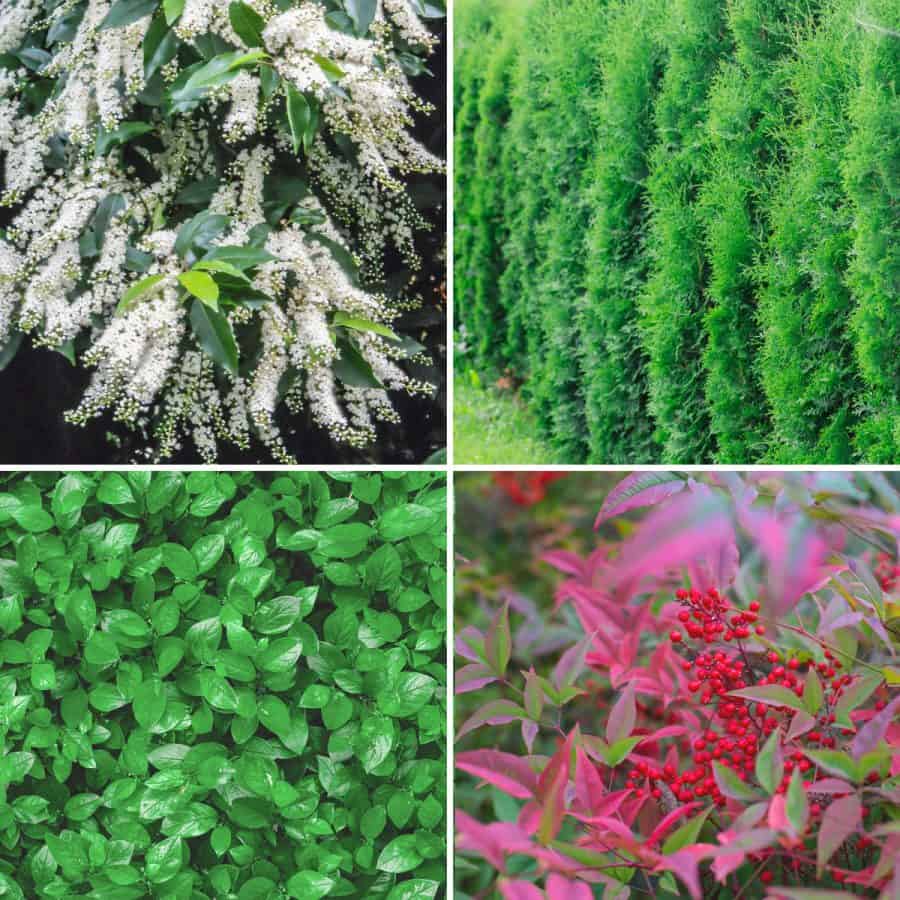
Spoiler alert: We recently purchased the Carolina cherry laurel, to fill in a large space where we needed a tall tree for privacy. We are quite pleased with how quickly it’s growing.
Best Evergreen Hedge Plants
- Yew
- Allegheny Barberry
- Cherry Laurel
- American Arborvitae
- Emerald Green Arborvitae
- Western Red Cedar
- Rocky Mountain Juniper
- Laurustinus
- Common Boxwood
- Portuguese Laurel
- Holly
- Evergreen Euonymus
- Oregon Grape
- Leyland Cypress
- Japanese Cleyera
- Cotoneaster Hedge
- Firethorn
- Privet
- Azaleas
- Canadian Hemlock
- False Cypress
- Mirror Bush
- Heavenly Bamboo
- Red Robin
- Griselinia
1. Yew | Taxus baccata

The commonly used evergreen bush is the yew. It’s a fairly slow-growing bush, so it’s ideal for a low-maintenance garden.
It is best that you pruned it in late summer or early fall.
Yew responds very well to regular pruning. If you have an overgrown yew shrub, you can often restore it by hard pruning in late winter.
It can vary considerably depending on the variety you choose, but yew plants can grow anywhere from 4 to 60 feet tall with a width of 4 to 20 feet.
2. Allegheny Barberry | Berberis canadensis

The barberry bush (or American barberry) is a traditional choice for security hedges due to its sharp thorns that line the branches.
Its bright red berries continue through the cold weather months, giving it more visual interest even in winter.
It has become less popular in North America due to its invasive nature. However, there are now new, non-invasive cultivars.
It tolerates many growing conditions and requires very little maintenance or pruning. Barberry can reach 3 to 6 feet in height and 4 to 7 feet wide.
3. Cherry Laurel | Prunus caroliniana

The Carolina cherry laurel is a great native choice for the English laurel. It’s a small evergreen shrub to a small tree that can easily grow up to 35 feet tall and 15 to 25 feet wide.
When the leaves are crushed, they have a maraschino cherry fragrance.
While full sun is preferred, it tolerates shade as long as the soil is moist and well-drained.
It can withstand heavy pruning, is drought tolerant, and is moderately salt tolerant.
4. American Arborvitae | Thuja

Also known as green giant arborvitae, it’s a coniferous cypress cedar tree with a pyramidal shape that can reach heights of 40 feet.
This dense hedge is excellent for privacy and is a favorite habitat for birds and squirrels.
It can be grown in almost any soil condition, requires no pruning, and is pest and deer resistant.
Another common variety is the Thuja occidentalis (white cedar).
This one can be grown in pots, does great in winter- even in pots, so is great as a privacy screen on a porch or patio. If you’re looking for more for your outdoor space, this article has a list of great DIY tutorials for backyard privacy screens.
5. Emerald Green Arborvitae | Thuja occidentalis ‘Smaragad’
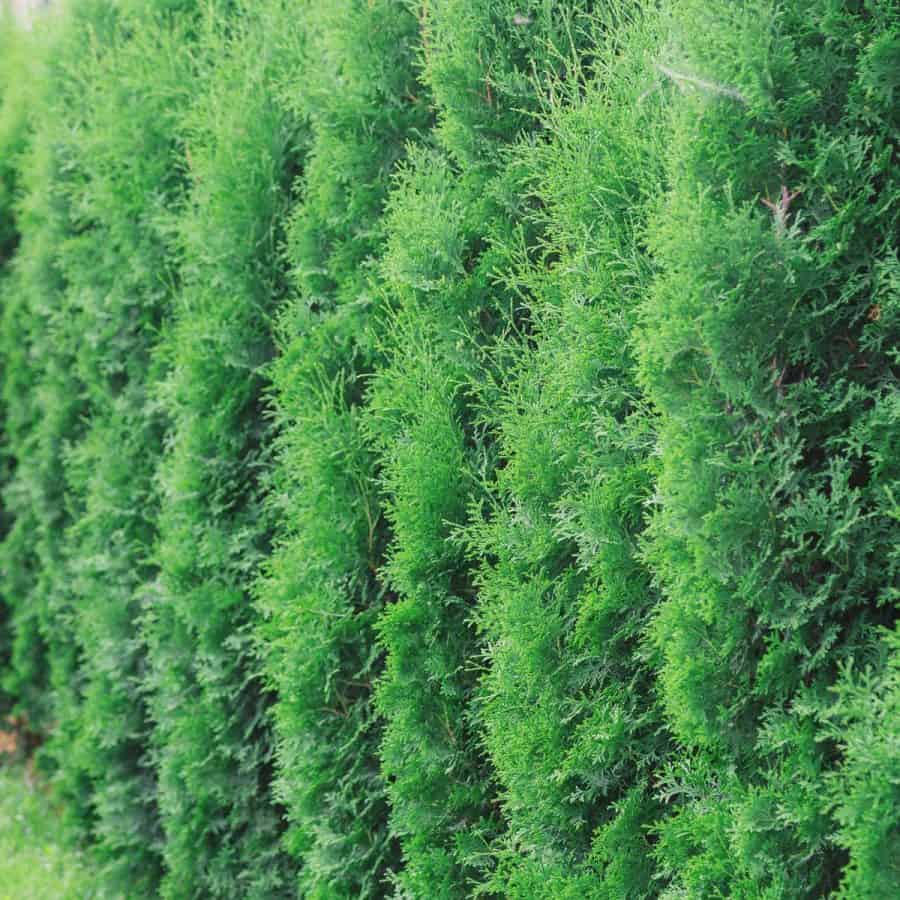
This shrub is one of the most popular choices for a privacy screen. Its narrow, pyramidal shape has dense foliage that thrives in heat and humidity.
You can expect the emerald green to grow anywhere between 20 to 40 feet tall.
They’re low-maintenance and resistant to insects and disease.
Do you have a smaller yard? You can check out this article with a full list of small trees for privacy.
6. Western Red Cedar | Thuja plicata
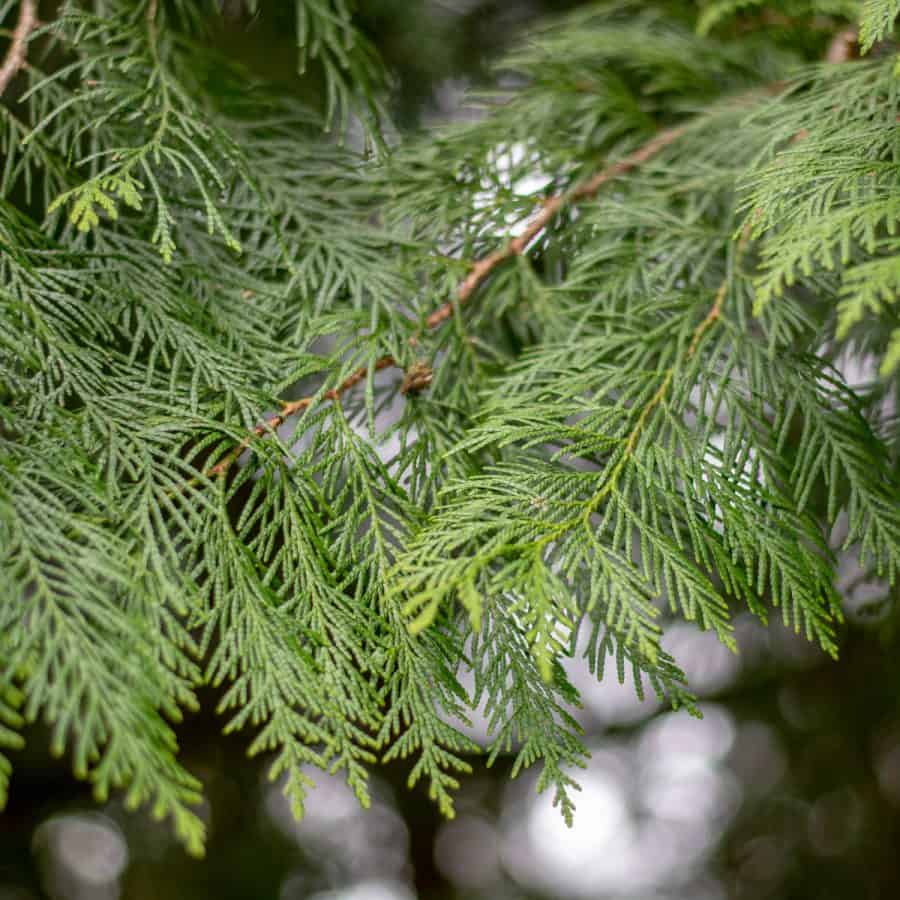
This Western red cedar is part of the Cypress family and is a cross between T. plicata x T. standishii.
It is known for its dark green foliage and natural conical shape. The cultivated tree will likely grow to 50 to 70 feet.
Its tall, dense nature is perfect for putting along a driveway or closing off a backyard or other space. It does well in full sun to partial shade.
7. Rocky Mountain Juniper | Juniperus scopulorum

The bright blue-gray needles make this a stunning option. It forms a pyramidal shape naturally and has exfoliating red-brown bark.
Rocky Mountain junipers have a mature height of 20 to 30 feet and spread 8 to 12 feet wide.
8. Laurustinus | Viburnum tinus
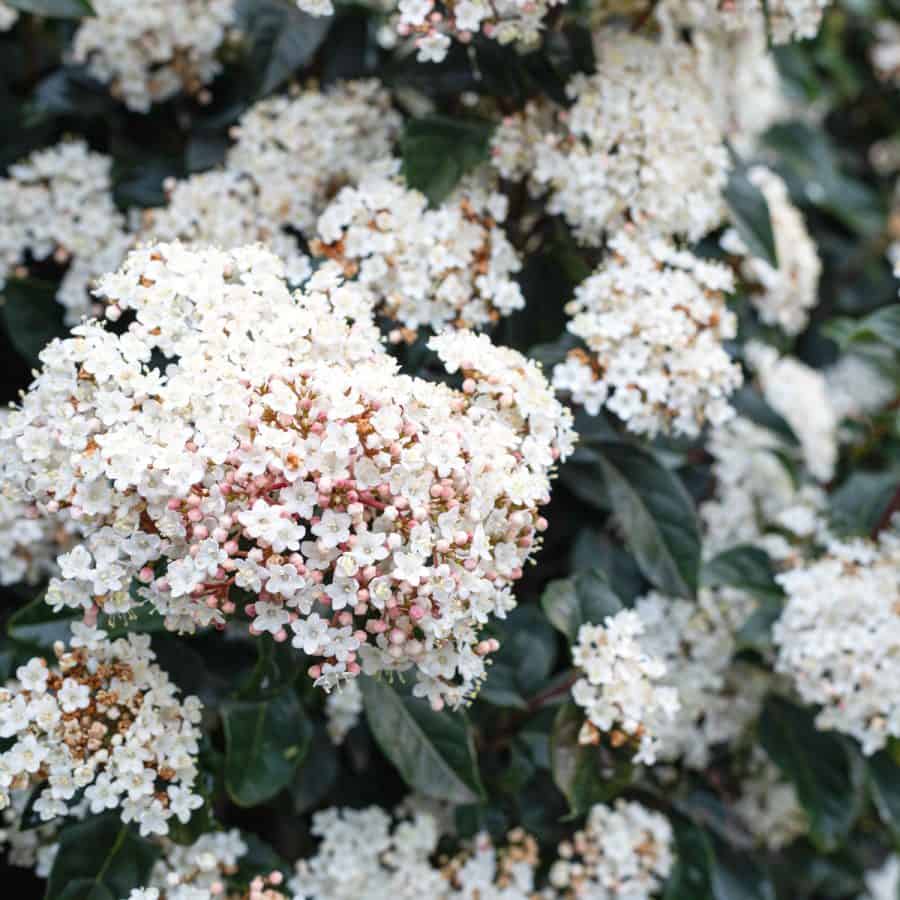
Laurustinus offers color and texture all year round. During the winter, pink buds abound. The spring brings white flowers, and dark blue berries come in early summer.
The abundance of flowers and berries invites pollinators and birds. It’s also an incredibly hardy plant. Overall, it’s one of the best hedging plants.
Laurustinus grows up to 8 feet tall and 6 feet wide.
9. Common Boxwood | Buxus sempervirens

The common boxwood is one of the classic fast-growing hedges and is perfect as a hedge plant.
It can reach significant heights and widths but is typically pruned smaller for hedges.
The oval-shaped dark green leaves are often pruned into a box shape, hence the name, to line walkways and gardens. It does well in full sun to partial shade and in well-drained soil.
The boxwood responds well to pruning and shaping, making it great for hedges and topiaries.
When clipped, the tiny leaves remain tidy. Prune in late spring as new growth darkens.
The common boxwood grows to a height of 15 to 20 feet and a spread of 15 to 20 feet when it matures.
10. Portuguese Laurel | Prunus lusitanica
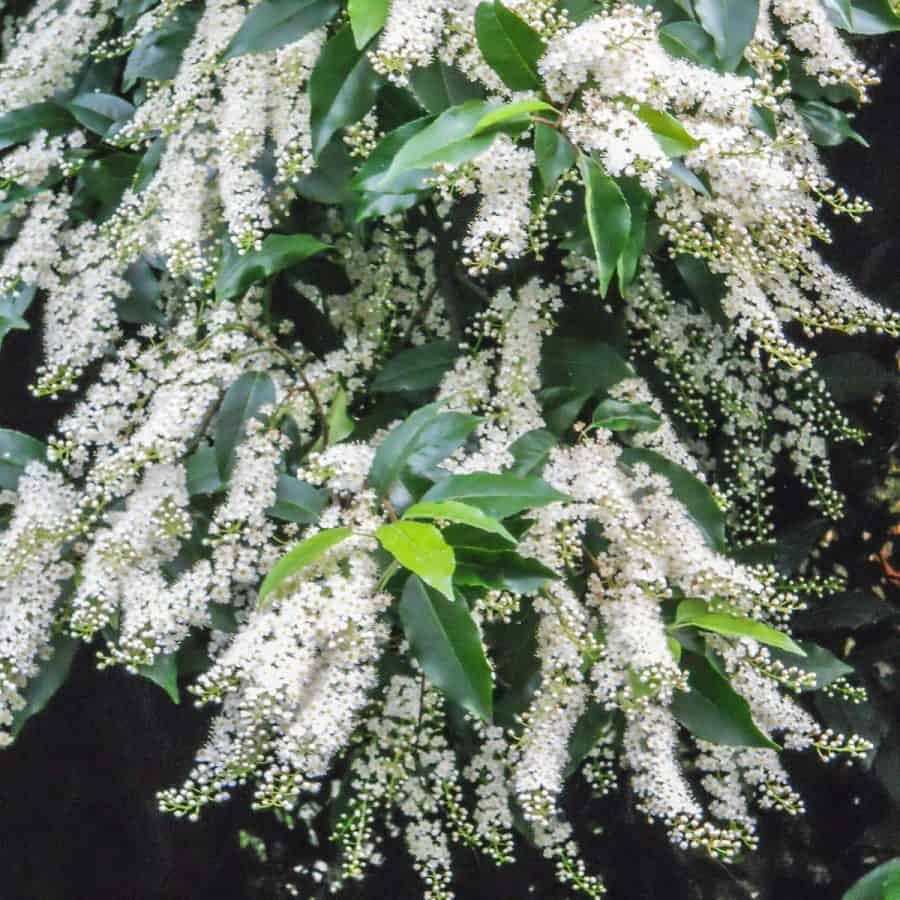
The Portuguese laurel has lovely green leaves that curve away from its maroon stems. It’s an easy-to-grow hedge that you can cut back hard if needed.
It’s best you prune it from late summer to autumn to yield a dense hedge. At maturity, it can reach 20 feet tall and 20 feet wide.
11. Holly | Ilex

Well-known for their glossy, sharp green leaves and bright red berries, hollies look their best when pruned and full.
Holly bushes prefer acidic soil, are medium growers, and reach 6 to 10 feet tall.
Some common varieties are the Japanese holly (Ilex crenata), American holly, Yaupon holly (pictured above), and English holly (Ilex aquifolium).
12. Evergreen Euonymus | Euonymus japonicus
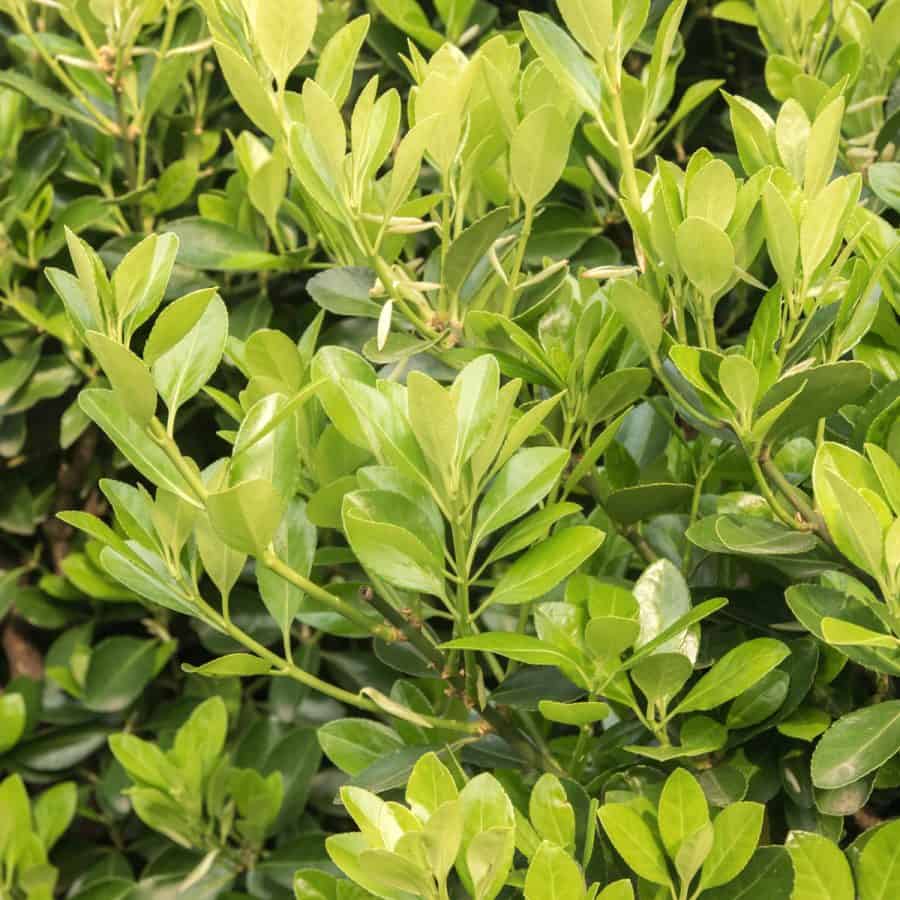
One of the best evergreen hedge plants is the very dense evergreen euonymus. It doesn’t need full sun and is a good choice for that shady spot.
It produces small and fragrant white flowers, it’s drought tolerant, and it reaches heights of 10 to 15 feet.
13. Oregon Grape | Mahonia aquifolium

The Oregon grape is an evergreen shrub that produces purple berries in the fall.
This native plant is drought-tolerant and grows between 3 to 10 feet in height and approximately 3 feet wide.
The inner bark of the larger stems yields a natural yellow dye, and the plant is often used for making wreaths or filler in floral arrangements.
14. Leyland Cypress | Cupressus × leylandii

The Leyland cypress is a quick-growing shrub, growing nearly three feet a year with little effort.
Along with being fairly low maintenance, it’s also fragrant and has dense foliage, making it one of the best evergreen shrubs.
The Leyland cypress grows to a height of 60 to 70 feet and a spread of 15 to 25 feet.
15. Japanese Cleyera | Ternstroemia gymnanthera
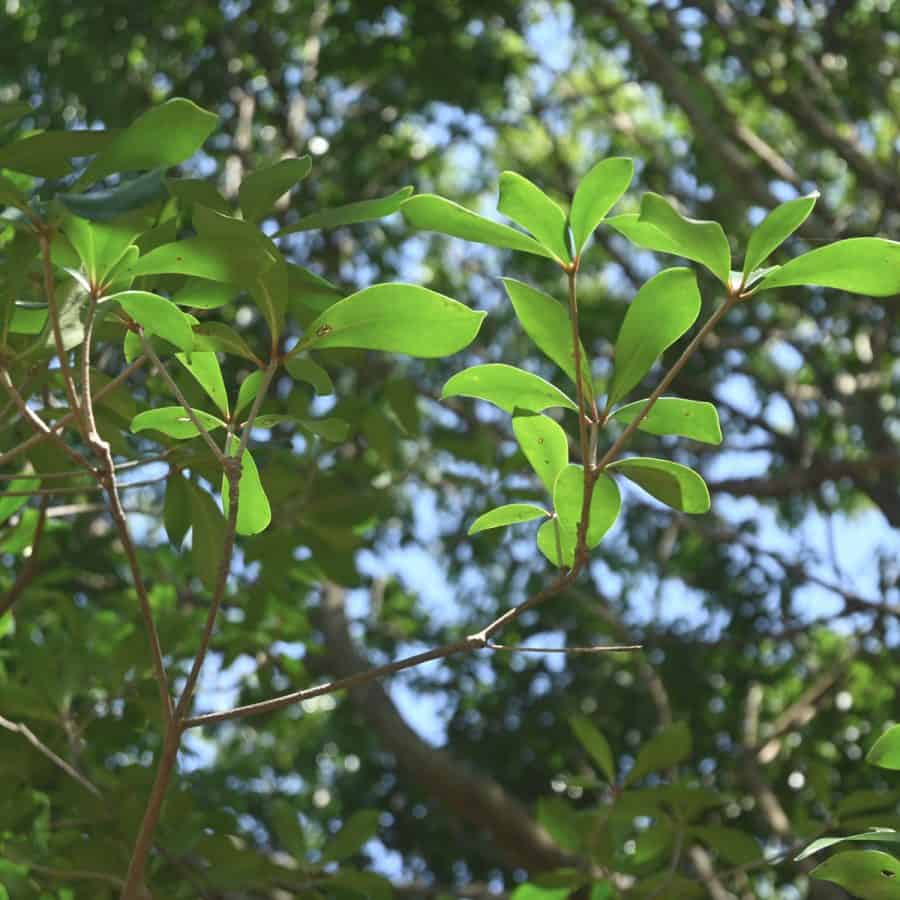
Cleyera hedges create low-maintenance privacy screens. They produce attractive glossy foliage that is evergreen.
Although grown primarily for its foliage, it also puts off fragrant white flowers and dark red berries.
Cleyera shrubs grow between 8 to 10 feet with a spread of about 6 feet.
16. Cotoneaster Hedge | Cotoneaster lucidus

Cotoneaster has leaves that are dark green and glossy. It has a rounded and dense shape, making for a great private shrub. The flowers are petite and are whitish-pink.
While it has and can be used as a hedge plant, it would be on the shorter side at 6-10 feet tall. However, its spread is about the same width as its height.
By the way, there is also a creeping version that works great as ground cover and is only 1 foot tall.
Smaller hedges look great in areas like gravel gardens, where sometimes less is more.
17. Firethorn | Pyracantha coccinea

Despite being a bit unruly, firethorns look striking. It is an evergreen shrub with white flowers in the spring and orange-red berries from summer into winter.
Firethorn is fast-growing, drought-tolerant, and does well in full sun to partial shade. It grows up to 6 to 12 feet tall and wide.
18. Privet | Ligustrum

Privets are broadleaf shrubs that put out white flowers. Be sure to pay attention to which variety of privets you’re looking at, as not all are evergreen.
Under the right conditions, privets are easy to grow, reaching heights of 8 to 20 feet and spreading 6 to 8 feet.
Once mature, they are tolerant to some drought conditions. They also handle heavy pruning well.
Please be sure the privet species you choose is not invasive to your area. The species in our photo is Japonicum.
For instance, in the southeastern US, Chinese privet is regarded as a seriously invasive, aggressive species and is nearly impossible to control as it colonizes large areas. Yet, nurseries still sell them.
19. Azaleas | Rhododendron Nova Zembla

Similar to privets, azaleas can be evergreen or deciduous hedging plants.
But if you’re looking for something with more obvious flowers, azaleas are far superior to privets.
Nova zembla rhododendron is a good choice. It has a dense structure, blooms in mid-spring, and offers good fall color.
Azaleas generally do best with well-drained soil and partial shade. The flowers are large and lush and come in a deep pink.
Azaleas have mature heights of 2 to 4 feet, with a spread of 1 to 4 feet.
20. Canadian Hemlock | Tsuga canadensis
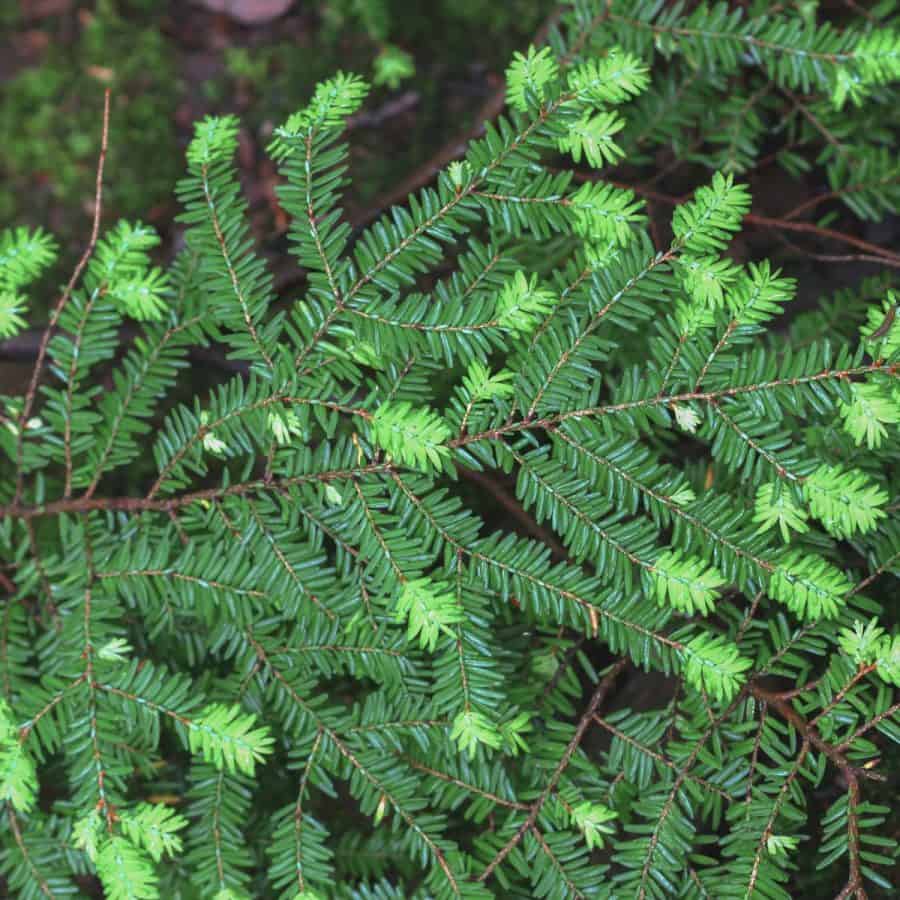
In the wild, Canadian hemlocks grow as trees. But they are often sold in shrub form for use in hedge planting.
They do well with yearly pruning, but they don’t do well with wind, drought, or high temperatures. Soil should be moist but have good drainage.
The Canadian hemlock grows to a height of 40 to 70 feet and a spread of 25 to 35 at maturity.
21. False Cypress | Chamaecyparis pisifera

False cypress is an evergreen conifer grown as a tree or shrub.
It has soft fern-like needles, is deer resistant, and does well in full sun to partial sun.
There are even dwarf varieties that are great for small spaces.
22. Mirror Bush | Coprosma repens

This evergreen, also known as a looking-glass plant, has glossy leaves in various colors. It survives in warmer climates, or you can have it in a pot in colder regions and bring it indoors.
It does give off a not-so-great smell when you crush the leaves, so that’s something to keep in mind.
Mirror bushes reach a mature height of 3 to 5 feet and a width of about 4 to 6 feet.
23. Heavenly Bamboo | Nandina domestica
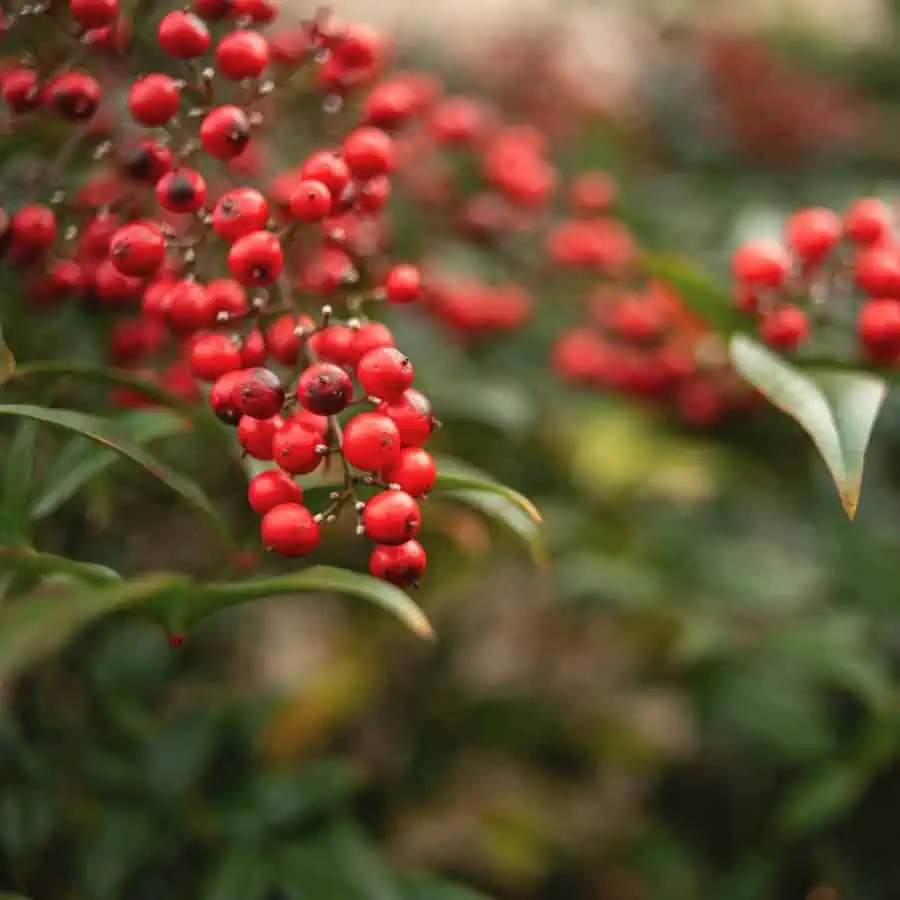
This plant is trendy in the southern US, with its most striking berries.
White spring flowers appear in clusters similar to hydrangeas, followed by red berries in the fall and winter.
It grows medium to fast, and it is best you prune it before new growth. It achieves heights up to 4 to 8 feet tall and 2 to 4 feet wide.
Nandina is a species that tends to be invasive in many areas, so check its status in your region before purchasing. Its berries are also toxic to Cedar waxwings. It’s best to prune the berries once they appear.
Native Beautyberry shrub (allicarpa americana) is a great alternative.
24. Red Robin | Photinia

Despite its name, the red Robin bush displays different colors as the seasons change.
Its large, coppery red leaves stand out in the spring and summer months. During the colder months, its foliage shifts to vivid deep green foliage.
Red robins will generally grow about 13 feet high and wide.
25. Griselinia | Griselinia littoralis
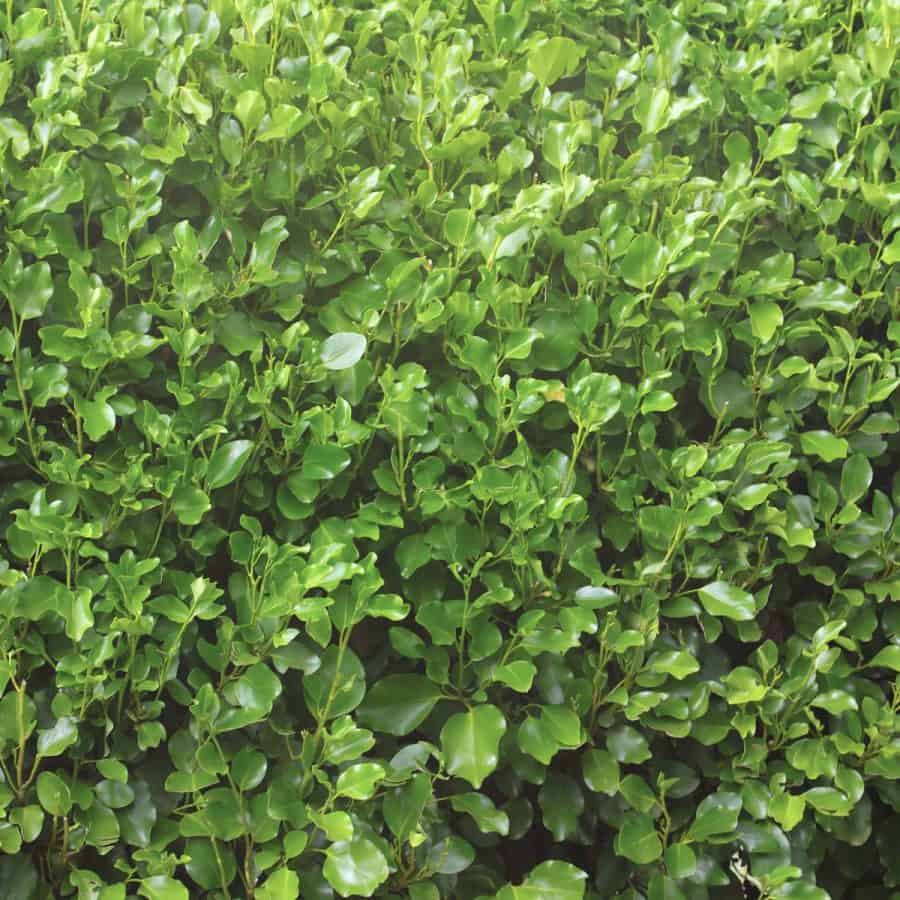
Griselinia is particularly great for coastal areas as it is resistant to salt, cold temperatures, and strong winds.
Not only does it have protective qualities, but it’s attractive as well. It is dense and has oval-shaped bright green leaves.
These hedges grow to approximately 6 feet tall and about 2 feet wide.
Tips for Planting Evergreen Hedge Plants
- Do not plant in a straight line. Zig-zag the trees to give a fuller effect and allow the trees to get air and sun. It also works best with the wind this way. This is especially a great tip for trees that are susceptible to blight. Trust me on this one, I speak from personal experience. Leyland cypresses are known to suffer from this.
- Plant more than one variety in your border. This way, disease, and pests will be less likely to destroy the whole planting.
- Generally speaking, plants should be spaced approximately the same distance as their overall mature width. So if a hedge grows to 8 feet, you would space these 8 feet apart from the trunk.
- Plant an extra couple of shrubs elsewhere. If something goes wrong with one plant, you have a replacement that’s the same size and type.
What is the fastest-growing evergreen for privacy?
Thuja Green Giant is an excellent choice as a fast-growing privacy tree. It grows 3 to 5 feet per year. Another option is the Leyland cypress.
The best evergreen hedge plants are essential components of landscaping design.
Evergreen hedges add color, texture, and dimension to your garden all year long. And, in addition to privacy, they also provide a wealth of other benefits, like wind protection and even noise reduction.
With their low maintenance, beautiful foliage, and many other advantages, evergreen hedges are the perfect plants to enhance your outdoor space.
For more yard plant inspiration, here’s an article on some of the best climbing plants for a trellis or fantastic ground covers for shady spots.
Don’t forget to Pin it for later!

Don’t forget to Pin it for later!



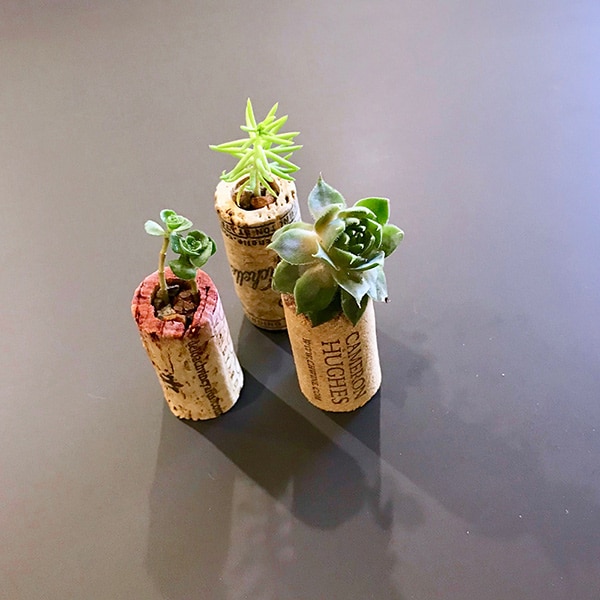


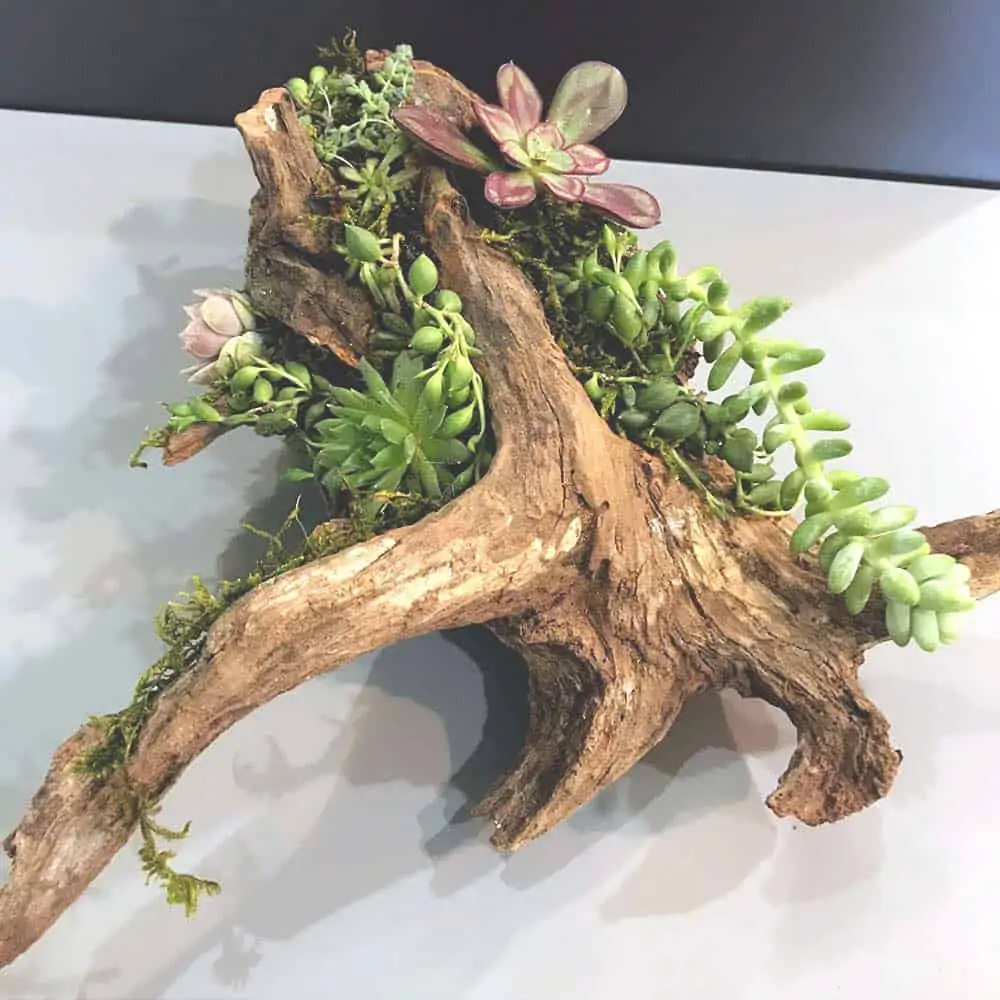
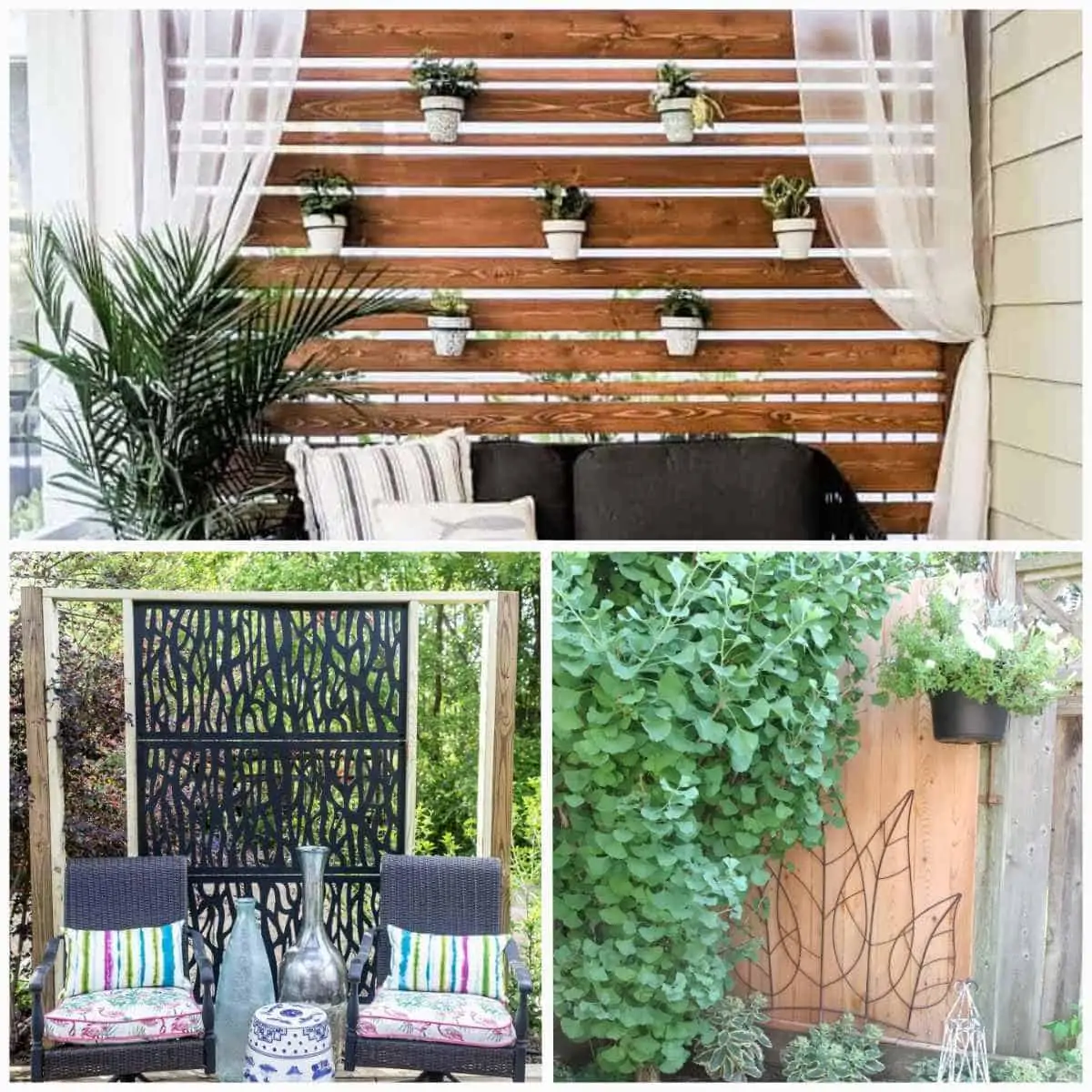
A shrub with red and green leaves and red berries is pictured but not in the detailed list of shrubs. What is the shrub pictured?
Hi Patrick,
That’s #23 heavenly bamboo/nandina. Just a photo of it at a different time of year. I’ll make a point to add a label.
Thank you Ellen